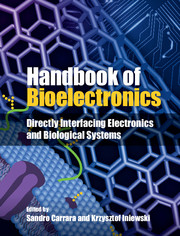Book contents
- Frontmatter
- Contents
- List of Contributors
- 1 What is bioelectronics?
- Part I Electronic components
- Part II Biosensors
- Part III Fuel cells
- Part IV Biomimetic systems
- 18 Biomimetic systems
- 19 Epidermal electronics – flexible electronics for biomedical applications
- 20 Bioelectronics brain using memristive polymer statistical systems
- 21 Electronic modeling of synthetic genetic networks
- Part V Bionics
- Part VI Brain interfaces
- Part VII Lab-on-a-chip
- Part VIII Future perspectives
- Index
- References
19 - Epidermal electronics – flexible electronics for biomedical applications
from Part IV - Biomimetic systems
Published online by Cambridge University Press: 05 September 2015
- Frontmatter
- Contents
- List of Contributors
- 1 What is bioelectronics?
- Part I Electronic components
- Part II Biosensors
- Part III Fuel cells
- Part IV Biomimetic systems
- 18 Biomimetic systems
- 19 Epidermal electronics – flexible electronics for biomedical applications
- 20 Bioelectronics brain using memristive polymer statistical systems
- 21 Electronic modeling of synthetic genetic networks
- Part V Bionics
- Part VI Brain interfaces
- Part VII Lab-on-a-chip
- Part VIII Future perspectives
- Index
- References
Summary
Most people are impressed, if not amazed, at the fantastic progress in the biomedical field, which barely existed 50 years ago. There have been giant leaps not just in the manner in which technology is being used to treat patients, but also in the way the electronics and sensors have diffused into society and resulted in paradigm shifts in health monitoring. Electronic microsystems can now be ingested (e.g. swallowable capsules) to explore the gastrointestinal tract and can transmit the acquired information to a base station [1]. The march of electronic technologies to the atomic scale and to non-planarity (i.e. three dimensions), and rapid advances in system, cell, and molecular biology will forge an increased synergy between electronics and biology, and we can see more exciting opportunities in the near future. For example, in the next decade it may become possible to restore vision or reverse the effects of spinal cord injury or disease, or for a lab-on-a-chip to allow medical diagnoses without a clinic, or instantaneous biological agent detection. Some of these fields are discussed in detail in other chapters of this book. Similarly, we may see new ways of recording neural signals or brain–machine interfaces if the electronics could become ultra-thin, bendable, and stretchable, and thus integrate intimately with the soft, curvilinear surfaces of biological tissues. Some of these developments are discussed in Chapters 22–27. Recent results in this direction are encouraging and make it a real possibility in the near future [2,3]. This chapter is about this key enabler, i.e. epidermal electronics, which will lead to further convergence of biology and electronics. The term epidermal electronics here also refers to electronic skin or e-skin (Figure 19.1), which is an ultra-thin and lightweight structure with electronic and/or sensing components on flexible/bendable substrates.
- Type
- Chapter
- Information
- Handbook of BioelectronicsDirectly Interfacing Electronics and Biological Systems, pp. 245 - 255Publisher: Cambridge University PressPrint publication year: 2015
References
- 15
- Cited by

